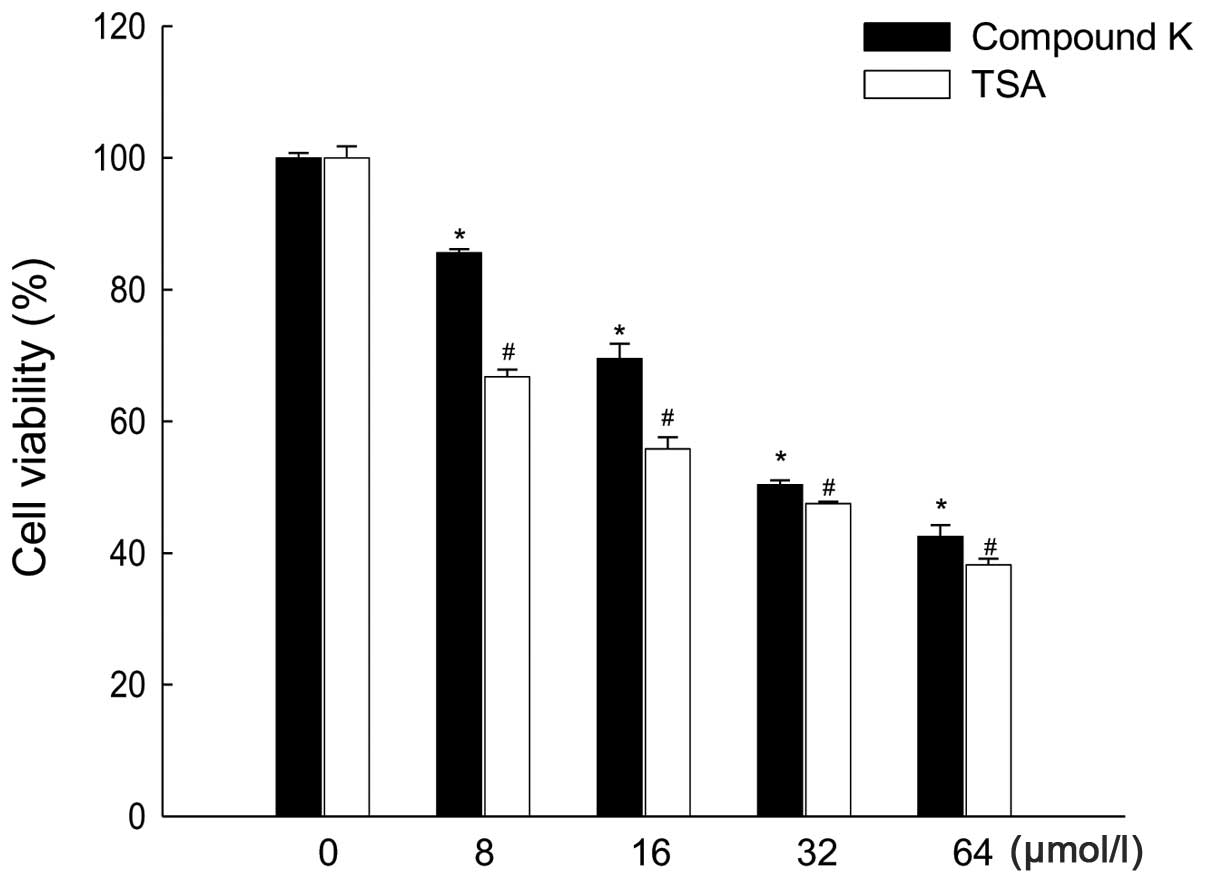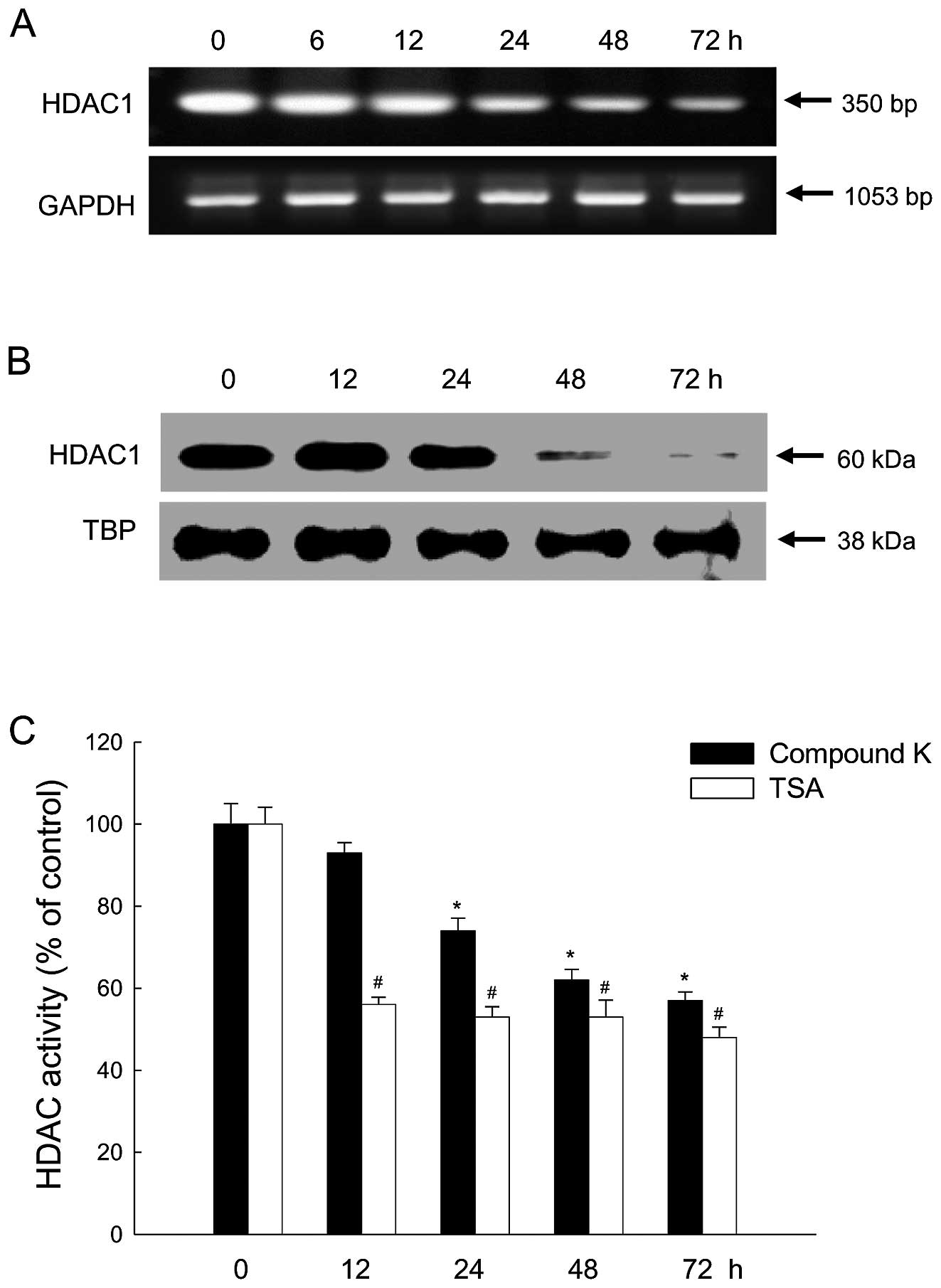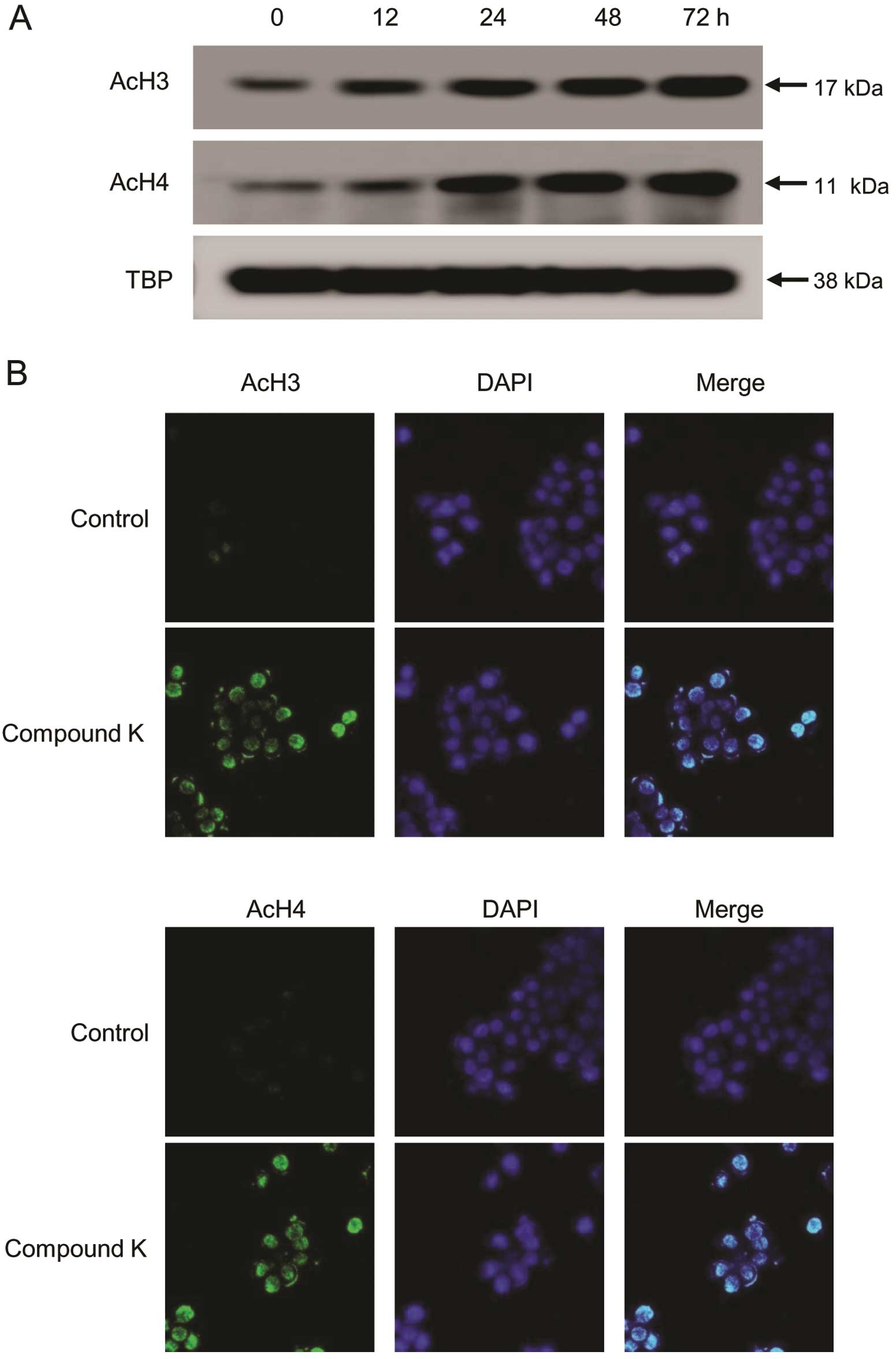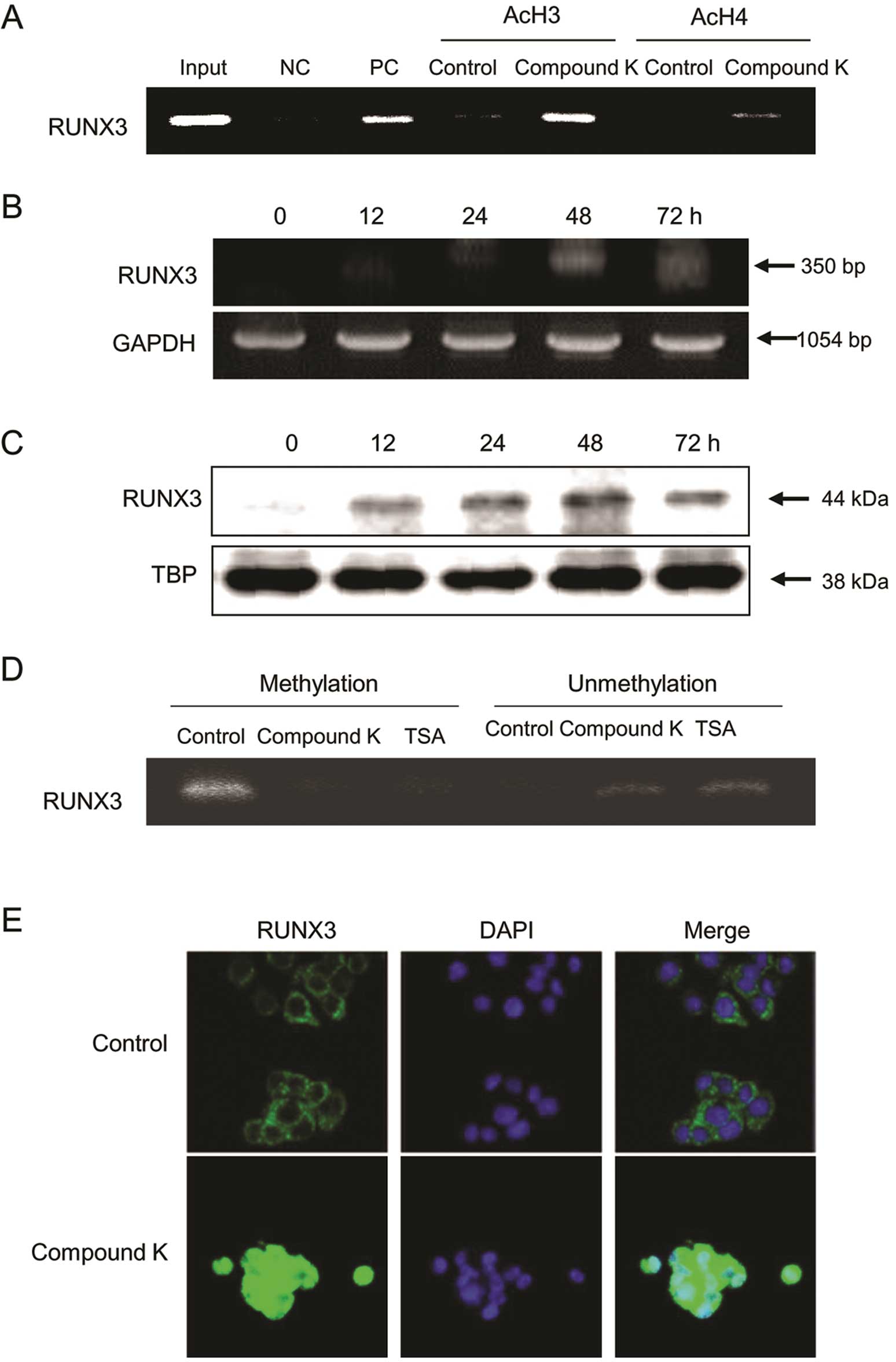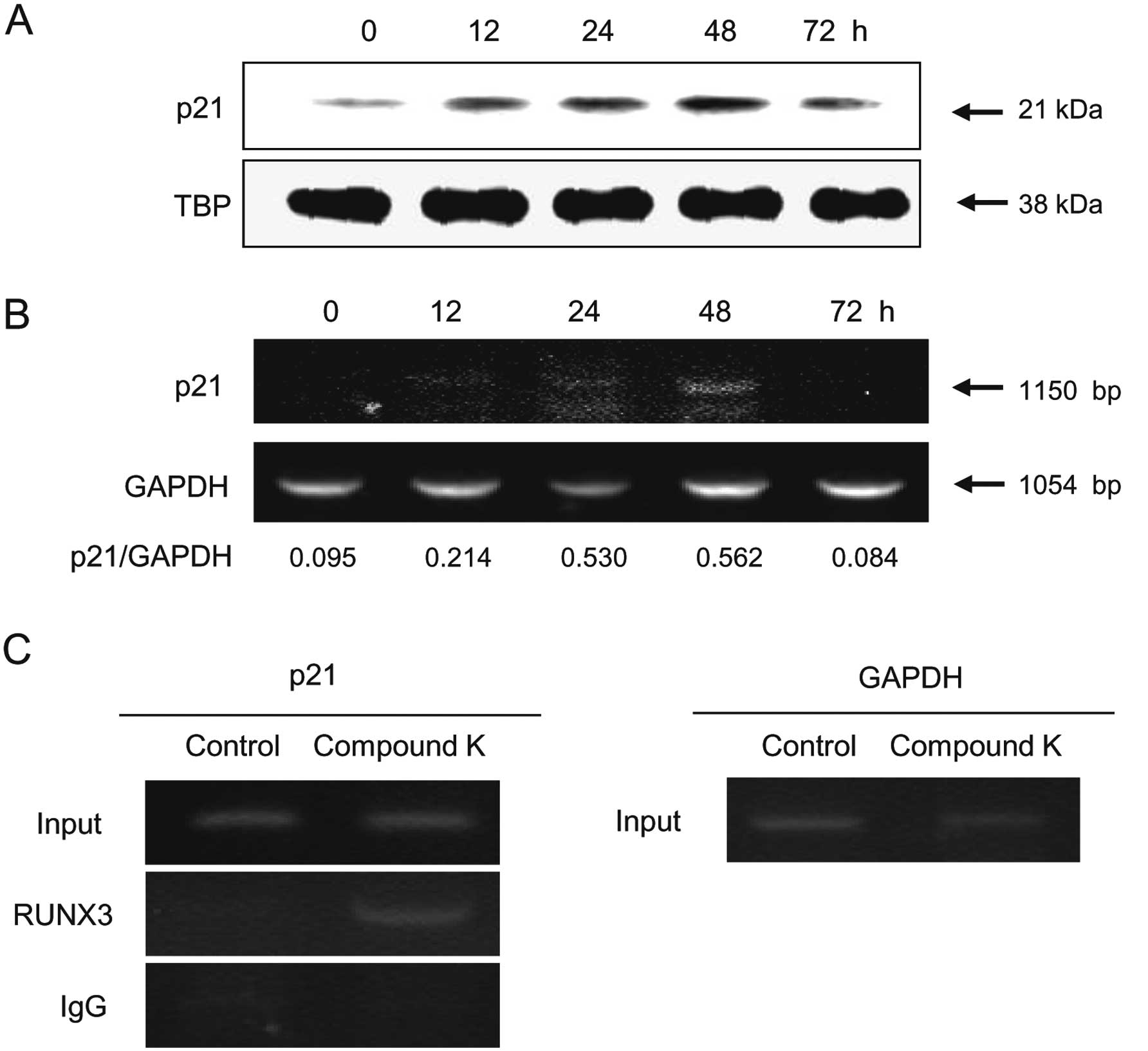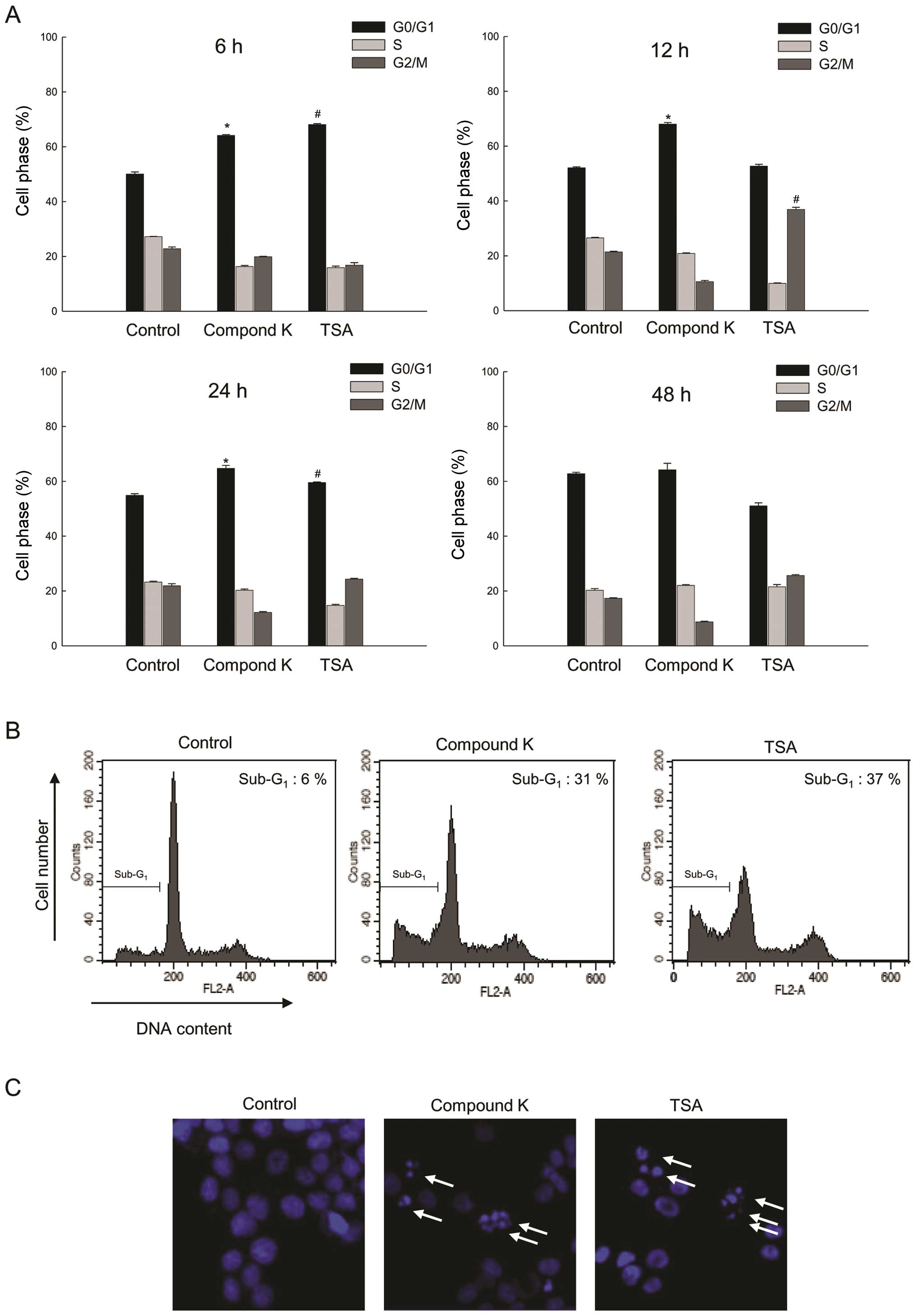Compound K, a metabolite of ginseng saponin, inhibits colorectal cancer cell growth and induces apoptosis through inhibition of histone deacetylase activity
- Authors:
- Published online on: October 4, 2013 https://doi.org/10.3892/ijo.2013.2129
- Pages: 1907-1914
Abstract
Introduction
Post-translational modifications of core histone proteins play a critical role in the regulation of gene expression (1). Acetylation of core histones by histone acetyltransferases is linked to chromatin opening and transcriptional gene activation; in contrast, histone deacetylases (HDACs) remove the acetyl group from histones and repress gene transcription (2). HDACs regulate many important biological processes, including cell cycle progression, differentiation and development (3).
Most studies performed to date have reported that, relative to adjacent normal mucosa, expression of HDAC1, HDAC2, HDAC3 and HDAC8, which all belong to the class I family of HDACs, is increased in colorectal carcinoma (4–9). Class I HDACs are frequently overexpressed in various human cancers, including colorectal cancer. Furthermore, their differential expression often correlates with drug resistance and poor prognosis, which makes them an attractive target for cancer therapeutics (10,11). Studies have demonstrated a role for class I HDACs in promoting colon cell proliferation and survival (4,7). Knockdown of HDAC1, 2 and 3 reduces the growth of several colon cancer cell lines including HCT-116, HT-29 and SW-480 (4,7,12). Mechanistically, the proliferative effects of HDACs in colon cancer cells have been linked to transcriptional repression of the cyclin-dependent kinase inhibitor, p21 (4,12). Knockdown of HDAC1, HDAC2 and HDAC3 induces p21 expression in colon cancer cell lines, while overexpression of these HDACs represses HDAC inhibitor-mediated p21 induction (13).
Recently, HDAC inhibitors such as suberoylanilide hydroxamic acid (SAHA) and trichostatin A (TSA) have emerged as a promising class of therapeutic drugs. Crystallographic analysis has shown that SAHA and TSA interact directly with the catalytic site of an HDAC-like protein and inhibit its enzymatic activity (14). Inhibition of HDAC activity by SAHA and related agents alters gene expression, causing cell cycle arrest and apoptosis in cancer cells, primarily by the induction of p21 and Bax, a pro-apoptotic protein (15). However, phase I and II studies have demonstrated that pan-HDAC inhibitors may have numerous side effects, such as bone marrow depression, diarrhea, disordered clotting and cardiac arrhythmias (16). Therefore, there is a clinical need for HDAC inhibitors that are both effective and minimally toxic.
Runt-related transcription factor 3 (RUNX3) belongs to the RUNX family of genes, which are important in mammalian development and neoplasia (17–19). RUNX3 cooperates with Sma- and Mad-related protein 3 (Smad3) and Smad4 to activate transforming growth factor-β (TGF-β-dependent growth inhibition and apoptosis by inducing p21 and Bim (20). The RUNX3 gene is localized to a locus at chromosome 1p36 and is linked with gastric epithelial homeostasis and gastric carcinogenesis. The 1p36 region is thought to harbor at least one tumor suppressor gene because this region exhibits frequent loss of heterozygosity in colon, gastric, breast and ovarian cancers (21). In addition, the introduction of a normal human 1p36 chromosome fragment into colon cancer cells suppresses their tumorigenicity (22). The RUNX3 gene is frequently inactivated through histone modification during the development of various carcinomas, including gastric and colon (20,22–25). Fujii et al demonstrated that enhancer of Zeste Homolog 2, a histone methytransferase, binds to the RUNX3 promoter, resulting in the upregulation of H3K27 methylation and concomitant downregulation of RUNX3 expression in colon cancer (26). Lee et al extended this finding by demonstrating that hypoxia-induced upregulated expression of HDAC1 and G9a, a histone methyltransferase, also causes epigenetic RUNX3 silencing through H3K9 methylation and decreased histone H3 acetylation at the RUNX3 promoter (27).
A number of saponins have been isolated from ginseng and their possible antitumor activity has been extensively investigated in various cancer cell lines (28–30). Among these saponins, 20-O-(β-D-glucopyranosyl)-20(S)-protopanaxadiol, or Compound K, is the main metabolite of protopanaxadiol-type ginsenoside, formed in the intestine after oral administration (31–33). Our laboratory recently reported that Compound K exhibits cytotoxicity by inducing apoptosis, arrest of growth at the G1 phase of the cell cycle and inhibition of telomerase activity in human leukemia cells (34,35). In addition, combined treatment with Compound K and gamma irradiation enhances the death of human lung cancer cells (36) and Compound K induces apoptosis in MCF-7 breast cancer cells by modulating AMP-activated protein kinase (37). In addition, we recently demonstrated that Compound K induces RUNX3 reactivation by DNA methyltransferase 1 inhibition (38).
The aims of this study were to determine whether Compound K suppresses HDAC activity and expression and to elucidate the molecular mechanisms by which Compound K induces cell cycle arrest and apoptosis. The results demonstrate that Compound K can downregulate HDAC1, leading to the accessibility of the RUNX3 promoter region in colorectal cancer HT-29 cells via increase of acetylation of histones H3 and H4. Downregulation of HDACs represents a novel mechanism underlying the ability of Compound K to induce cell cycle arrest and apoptosis.
Materials and methods
Cell culture
Human colorectal cancer HT-29 cells were obtained from the Korean Cell Line Bank (Seoul, Republic of Korea). Cells were maintained in an incubator at 37°C with a humidified atmosphere of 5% CO2. The cells were cultured in RPMI-1640 medium containing 10% fetal calf serum, streptomycin (100 μg/ml) and penicillin (100 U/ml).
Cell proliferation assay
Cell proliferation was determined using the 3-(4,5-dimethylthiazol-2-yl)-2,5-diphenyltetrazolium bromide (MTT) assay. Cells were seeded into a 96-well plate at a density of 1×105 cells/ml and were treated with 8, 16, 32 and 64 μmol/l of Compound K or TSA. After incubating for 48 h, 50 μl of the MTT stock solution (2 mg/ml) was added to each well to attain a total reaction volume of 250 μl. After 4 h incubation, the supernatants were aspirated; the formazan crystals in each well were dissolved in 150 μl dimethylsulfoxide and absorbance at 540 nm was measured using a scanning multi-well spectrophotometer (TECAN, Melbourne, Australia).
Reverse transcription polymerase chain reaction (RT-PCR)
Total RNA was isolated from cells using TRIzol reagent (Gibco BRL, Grand Island, NY, USA). Complementary DNA (cDNA) (1 μl) was amplified in a 25 μl reverse transcription reaction containing primers, dNTPs and 0.5 U of Taq DNA polymerase. The PCR conditions were 5 min at 94°C for initial denaturation, followed by 35 cycles of 1 min at 94°C, 1 min at 55°C and 1 min at 72°C and then a final elongation period of 7 min at 72°C. PCR amplification was carried out in a Perkin-Elmer Cetus 9600 thermal cycler (Roche Molecular Systems Inc., NJ, USA). The primers used to amplify the RUNX3 and HDAC1 cDNA were as follows: RUNX3 sense, 5′-GGCAATG ACGAGAACTAC-3′ (located in exon 2); RUNX3 antisense, 5′-GGAGAATGGGTTCAGTTC-3′ (located in exon 5); HDAC1 sense, 5′-AACCTGCCTATGCTGATGCT-3′; HDAC1 antisense, 5′-CAGGCAATTCGTTTGTCAGA-3′; GAPDH sense, 5-GTGGGCCGCCCTAGGCACCAGG-3′; and GAPDH antisense, 5′-GGAGGAAGAGGATGCGGCAGTG-3′. The amplified products were resolved on 1% agarose gels, which were stained with ethidium bromide and visualized under ultraviolet light using ImageQuant™ TL analysis software (Amersham Bioscience, Uppsala, Sweden).
Methylation specific (MS)-PCR
The bisulfate modification of DNA was carried out with the Methylamp™ DNA modification kit (Epigentek, Pittsburgh, PA, USA) according to the manufacturer’s instructions. For analysis of DNA methylation of RUNX3, MS-PCR carried out using an Epitect MSP kit (Qiagen, Valencia, CA, USA). The PCR products were separated on 6% non-denaturing polyacrylamide gels, stained with ethidium bromide and visualized under UV light. The methylated or unmethylated RUNX3 primer set is as follows: 5′-TTATGAGGGGTGGTTGTATGTGGG-3′ and 5′-AAA ACAACCAACACAAACACCTCC-3′ for unmethylated RUNX3; 5′-TTACGAGGGGCGGTCGTACGCGGG-3′ and 5′-AAAACGACCGACGCGAACGCCTCC-3′ for methylated RUNX3.
Western blot analysis
Cells were harvested and lysed on ice in 1 ml of lysis buffer (10 mmol/1 Tris-HCl, pH 7.9, 10 mmol/1 NaCl, 3 mmol/1 MgCl2 and 1% NP-40) for 4 min. After centrifugation for 10 min at 3,000 g, the pellets were re-suspended in 50 μl of extraction buffer (20 mmol/1 HEPES, pH 7.9, 20% glycerol, 1.5 mmol/1 MgCl2, 0.2 mmol/1 EDTA, 1 mmol/1 DTT and 1 mmol/1 PMSF) and then incubated on ice for 30 min and centrifuged at 13,000 g for 5 min. The protein concentration was measured and supernatants were stored at −70°C. Aliquots of the lysates (40 μg of protein) were boiled for 5 min and electrophoresed on a 10% SDS-polyacrylamide gel. Proteins were transferred onto nitrocellulose membranes, which were subsequently incubated with primary antibodies. The membranes were further incubated with secondary immunoglobulin-G-horseradish peroxidase conjugates (Pierce, Rockford, IL, USA). Protein bands were detected using an enhanced chemiluminescence western blotting detection kit (Amersham, Little Chalfont, UK) and were visualized using a luminescent image analyzer (BMG Labtech, Offenburg, Germany).
HDAC activity
Nuclear extracts were prepared using a nuclear protein extraction kit (Cayman Chemical, Ann Arbour, MI, USA). After measuring the protein concentration, the nuclear fractions were stored at −70°C. HDAC activity was measured using an EpiQuik HDAC activity assay kit (Epigentek, Brooklyn, NY, USA), according to the manufacturer’s instructions. In brief, the nuclear extracts were incubated with a specific substrate for 1 h at 37 °C, followed by capture antibody for 60 min and then detection antibody for 30 min at room temperature. Absorbance at 450 nm was measured using a microplate spectrophotometer (TECAN). HDAC activity was calculated as ng/h/ml = {[optical density (control-blank)-optical density (sample-blank)] / Slope × h} × sample dilution.
Immunocytochemistry
Cells plated onto coverslips were fixed with 4% paraformaldehyde for 30 min and permeabilized with 0.1% Triton X-100 in PBS for 15 min. Cells were treated with blocking medium (3% bovine serum albumin in PBS) for 1 h and then incubated for 2 h with the RUNX3 antibody in blocking medium. The primary acetylated histone H3, acetylated histone H4 and RUNX3 antibodies were detected by a FITC-conjugated secondary antibody (1:500; Santa Cruz Biotechnology, Santa Cruz, CA, USA) for 1 h. After washing with PBS, stained cells were mounted onto microscope slides in mounting medium with DAPI (Vector, Burlingame, CA, USA) and imaged using the LSM 510 program on a Zeiss confocal microscope (Carl Zeiss Microscopy Ltd., Cambridge, UK).
Chromatin immunoprecipitation (chIP) assay
The ChIP assay was performed using a Simple ChIP™ enzymatic chromatin IP kit (Cell Signaling Technology, Danvers, MA, USA), according to the manufacturer’s protocol with slight modifications. Briefly, cells were treated with 20 μg/ml of Compound K for 48 h and then cross-linked by the addition of 1% formaldehyde. Chromatin was prepared and digested with nuclease for 12 min at 37°C. ChIP was performed with the acetylated histone H3, acetylated histone H4 and RUNX3 antibodies [Cell Signaling Technology and Abeam (Cambridge, UK)] and normal mouse IgG. Antibodies were added to the chromatin digests and were incubated with constant rotation at 4°C overnight. ChlP-grade protein G magnetic beads were then added to capture the immune complexes. The beads were washed and the immunoprecipitates were eluted with ChIP elution buffer. The cross-links were reversed by incubation at 65°C for 30 min. Proteinase K was added and incubated at 65°C for 2 h. The immunoprecipitated DNA fragments were then purified using spin columns. DNA recovered from the immunoprecipitated complex was subjected to 35 cycles of PCR. The primers for the p21 (RUNX3 binding site) and RUNX3 (acetylated H3, H4 binding sites) gene promoters were as follows: p21 sense, 5′-CACCAGACTTCTCTGAGCCCCAG-3′; p21 antisense, 5′-GCACTGTTAGAATGAGCCCCCTTTC-3′; RUNX3 sense, 5′-GGTTGCAGAAGTCACAGG-3′; and RUNX3 antisense, 5′-AATTTGCTTAGAACGTCCG-3′. The PCR products were separated on 2% agarose gels and DNA bands were visualized using the Image program (NIH, Bethesda, MD, USA).
Flow cytometry
A flow cytometric assay was performed to assess the effects of Compound K or TSA on the cell cycle. Cells were treated with 32 μmol/l of Compound K or TSA for 48 h. Harvested cells were then washed twice with PBS and fixed in 70% ethanol for 30 min at 4°C. Subsequently, the cells were incubated in 50 mg/ml propidium iodide solution and 50 μg/ml RNase A in the dark for 30 min at 37 °C. Flow cytometric analysis was performed using a FACSCalibur flow cytometer (Becton-Dickinson, Mountain View, CA, USA). The cell cycle phases were assessed based on histograms generated by CellQuest and Mod-Fit software programs.
Nuclear staining with Hoechst 33342
A volume of 1.5 μl of Hoechst 33342 (10 mg/ml), a DNA-specific fluorescent dye, was added to each well and cells were incubated for 10 min at 37°C. To examine the degree of nuclear condensation, the stained cells were observed under a fluorescent microscope, which was equipped with a CoolSNAP-Pro color digital camera (Carsen Group, Markham, ON, Canada).
Statistical analysis
All measurements were performed in triplicate and values are expressed as the mean ± standard error of the mean (SEM). The results were examined using analysis of variance (ANOVA) and Tukey’s test to determine pairwise differences. P<0.05 was considered statistically significant.
Results
Compound K inhibits HDAC activity and expression in HT-29 cells
We recently demonstrated that Compound K acts as a DNA methyltrasferase inhibitor in human colorectal cancer cells (38); the present study provides evidence that Compound K also inhibits HDACs in human colorectal cancer HT-29 cells. Compound K and TSA inhibited HT-29 cell growth in a dose-dependent manner at concentrations between 8 and 64 μmol/l; the concentration that yielded 50% growth inhibition (IC50) was 32 μmol/l for Compound K and 24 μmol/1 for TSA (Fig. 1). As a result, 32 and 24 μmol/1 were chosen as the optimal doses of Compound K and TSA, respectively. Treatment of cells with the optimal dose of Compound K decreased HDAC1 mRNA and protein expression in a time-dependent manner (Fig. 2A and B). HDAC enzyme activity was reduced at all time-points in cells treated with TSA and enzyme activity was also decreased in a time-dependent manner in cells treated with Compound K (Fig. 2C).
Compound K increases histone acetylation
We then determined whether the decrease in HDAC expression and activity induced by Compound K affects histone acetylation. Compound K induced a significant increase in the acetylation of histones H3 and H4 in a time-dependent manner (Fig. 3A). Furthermore, direct immunofluorescence analysis revealed that acetylated histones H3 and H4 are present in the nuclei of HT-29 cells following treatment with Compound K (Fig. 3B).
Compound K reactivates RUNX3 via inhibition of HDAC
The RUNX3 gene in HT-29 cells is reportedly epigenetically silenced (39–43). ChIP analysis revealed acetylation of the RUNX3 promoter in Compound K-treated HT-29 cells (Fig. 4A), which resulted in the time-dependent re-expression of RUNX3 mRNA (Fig. 4B) and protein (Fig. 4C). We then investigated whether the status of DNA methylation in the RUNX3 promoter region changed after treatment of Compound K and resulted in restoration of RUNX3 gene expression. It was shown that unmethylation of the RUNX3 promoter region induced in HT-29 cells by treatment of Compound K, as well as TSA (Fig. 4D). Mislocalization of nuclear RUNX3 protein to the cytoplasm was also observed in HT-29 cells; however, treatment of cells with Compound K increased the nuclear localization of the RUNX3 protein (Fig. 4E).
Compound K induces RUNX3-mediated expression of p21
RUNX3 cooperates with Smad3 and Smad4 to activate TGF-β-dependent growth inhibition and also causes apoptosis by inducing p21 and Bim (20,41). Enhanced p21 mRNA (Fig. 5A) and protein (Fig. 5B) expression was observed in HT-29 cells following Compound K treatment. Additionally, ChIP assay data showed that RUNX3 interacted with p21 (Fig. 5C); therefore, Compound K induced p21 expression via the binding of RUNX3 to the p21 promoter region.
Compound K induces cell cycle arrest and apoptosis
Analysis of DNA content by flow cytometry revealed that Compound K and TSA caused a marked increase in the percentage of cells in the G0/G1 phases of the cell cycle. Following Compound K treatment of HT-29 cells, the cell population in the G0/G1 phase at 6 and 12 h was 64 and 68% comparing to 50 and 52% cell population in the G0/G1 phase of control group; following TSA treatment, 69% was in the G0/G1 phase at 6 h and 37% in the G2/M phase at 12 h compared to 50% in the G0/G1 phase at 6 h and 21% in the G2/M phase at 12 h of control group (Fig. 6A). Furthermore, the sub-G1 population (Fig. 6B) and apoptotic body formation (Fig. 6C) were increased in Compound K-treated cells compared with control cells.
Discussion
Epigenetic gene regulation plays a crucial role in the etiology of cancer. Post-translational histone modifications are important epigenetic events in the regulation of gene expression and maintenance of cellular function, which may contribute to cancer development (44–46). Abnormal histone modification is a hallmark of cancer that often causes silencing of tumor suppressor genes, which in turn leads to cancer development and progression. The anti-carcinogenic effects and preventative action of Compound K, the main metabolite of ginseng saponin, against colorectal cancer have been extensively studied in various tumor models (35–37,47); however, less attention has been given to the epigenetic modifications induced by Compound K and their potential role in reducing the risk of developing colorectal cancer. In this study, Compound K induced the transcription of RUNX3 and p21 transcription factors and reduced DNA methylation of RUNX3. Also, this Compound K increased acetylation of histones H3 and H4, leading to cell cycle arrest and apoptosis.
Class I HDACs are overexpressed in human colorectal cancer specimens and colorectal cancer cell lines (5,48); specifically, HDAC1, HDAC2 and HDAC3 are highly expressed in colorectal cancer (11). Overexpression of HDAC1 in prostate cancer cells causes increased cell proliferation and a reduction in cell differentiation markers; HDAC1 may therefore represent a putative therapeutic target for cancer (49,50). HDACs form multi-subunit transcriptional co-repressor complexes that are recruited to promoter regions by sequence-specific transcription factors (51). There are reportedly several co-repressor complexes for distinct promoters, which recruit specific HDAC isoforms that silence their target genes. Class I HDACs are specifically responsible for deacetylation of the catalytic core of different co-repressor complexes, resulting in transcriptional repression. For example, HDAC1 and HDAC2 are present in the CoREST, mi2/NURD and Sin3 complexes and HDAC3 is responsible for the catalytic activities of the N-CoR and SRMT co-repressor complexes (51). Silencing of RUNX3 by HDACs plays an important role in the regulation of tumor suppression during gastric and colon carcinogenesis (26,27).
It is important to note that Compound K affects HDAC1 and therefore has profound effects on cancer cells; however, the specific mechanisms underlying these effects requires further clarification, specifically with regard to understanding the differential response of colorectal cancer cells to Compound K. Repression of tumor suppressor genes involves deacetylation of various transcription factors by class I HDACs (32,33). In addition, evidence to date indicates that specific HDACs are consistently overexpressed in colon cancer. The effect of overexpression and depletion of multiple class I HDACs on the growth and survival of colon cancer cells has been investigated in vitro in a number of studies; for example, deficiency of HDAC1, 2 and 3 reduces the growth of several colon cancer cell lines (4,7,12). In this study, we observed a differential response of Compound K-mediated cell death, probably due to significant inhibition of class I HDACs at the protein and mRNA levels. The results provide additional evidence that Compound K inhibits class I HDACs by altering the acetylated histone status and enhancing the expression of tumor suppressor genes and pro-apoptotic proteins. These effects were accompanied by corresponding increases in cell growth inhibition and apoptosis.
Tumor suppressor gene repression involves deacetylation of various transcription factors by class I HDACs. Class I HDAC-mediated deacetylation has been shown to decrease the DNA-binding activity of sequence-specific transcription factors. For example, covalent modifications of several transcription factors, including E2F, SP1/ SP3, p53, GATA1, TFIIF and RUNX3 by class I HDACs, have been reported (51–53). HDAC inhibitors reduce HDAC activity, altering the dynamic balance between HDAC and histone acetyl-transferase activity, which results in increased acetylation of non-histone proteins, including RUNX3. Deacetylation by HDAC1 and HDAC2 results in the silencing of RUNX3 and HDAC inhibitors have been shown to reverse this process (54,55). Inhibition of HDACs results in the acetylation of RUNX3, thereby increasing both its half-life and binding to the p21 promoter (54). Our chromatin immunoprecipitation assays confirmed an increase in the expression of acetylated histones H3 and H4 associated with the RUNX3 promoter in the nuclei of HT-29 cells.
In conclusion, this study demonstrates that Compound K can decrease HDAC enzyme activity and may be effective in inhibiting cancer cell growth. The degree of HDAC inhibition and the alterations in downstream gene expression induced by Compound K were similar to those induced by TSA, a pharmacological inhibitor of HDACs. Our data suggest that epigenetic regulation of tumor suppressor genes by Compound K may play a role in colorectal cancer chemoprevention or therapy. These findings are important for understanding the anticancer mechanisms and clinical applications of Compound K.
Acknowledgements
This study was supported by a grant from the National R&D Program for Cancer Control, Ministry for Health and Welfare, Republic of Korea (1120340).
References
|
Kouzarides T: Chromatin modifications and their function. Cell. 128:693–705. 2007. View Article : Google Scholar : PubMed/NCBI | |
|
Strahl BD and Allis CD: The language of covalent histone modifications. Nature. 403:41–45. 2000. View Article : Google Scholar : PubMed/NCBI | |
|
Gallinari P, Di Marco S, Jones P, Pallaoro M and Steinkühler C: HDACs, histone deacetylation and gene transcription: from molecular biology to cancer therapeutics. Cell Res. 17:195–211. 2007.PubMed/NCBI | |
|
Wilson AJ, Byun DS, Popova N, Murray LB, L’Italien K, Sowa Y, Arango D, Velcich A, Augenlicht LH and Mariadason JM: Histone deacetylase 3 (HDAC3) and other class I HDACs regulate colon cell maturation and p21 expression and are deregulated in human colon cancer. J Biol Chem. 281:13548–13558. 2006. View Article : Google Scholar : PubMed/NCBI | |
|
Nakagawa M, Oda Y, Eguchi T, Aishima S, Yao T, Hosoi F, Basaki Y, Ono M, Kuwano M, Tanaka M and Tsuneyoshi M: Expression profile of class I histone deacetylases in human cancer tissues. Oncol Rep. 18:769–774. 2007.PubMed/NCBI | |
|
Ishihama K, Yamakawa M, Semba S, Takeda H, Kawata S, Kimura S and Kimura W: Expression of HDAC1 and CBP/p300 in human colorectal carcinomas. J Clin Pathol. 60:1205–1210. 2007. View Article : Google Scholar : PubMed/NCBI | |
|
Zhu P, Martin E, Mengwasser J, Schlag P, Janssen KP and Göttlicher M: Induction of HDAC2 expression upon loss of APC in colorectal tumorigenesis. Cancer Cell. 5:455–463. 2004. View Article : Google Scholar : PubMed/NCBI | |
|
Huang BH, Laban M, Leung CH, Lee L, Lee CK, Salto-Tellez M, Raju GC and Hooi SC: Inhibition of histone deacetylase 2 increases apoptosis and p21(Cipl/WAFl) expression, independent of histone deacetylase 1. Cell Death Differ. 12:395–404. 2005. View Article : Google Scholar : PubMed/NCBI | |
|
Giannini R and Cavallini A: Expression analysis of a subset of coregulators and three nuclear receptors in human colorectal carcinoma. Anticancer Res. 25:4287–4292. 2005.PubMed/NCBI | |
|
Weichert W, Röske A, Niesporek S, Noske A, Buckendahl AC, Dietel M, Gekeler V, Boehm M, Beckers T and Denkert C: Class I histone deacetylase expression has independent prognostic impact in human colorectal cancer: specific role of class I histone deacetylases in vitro and in vivo. Clin Cancer Res. 14:1669–1677. 2008. View Article : Google Scholar | |
|
Beckers T, Stephan C, Jung K, Fritzsche FR, Niesporek S, Denkert C, Dietel M and Kristiansen G: Histone deacetylases 1, 2 and 3 are highly expressed in prostate cancer and HDAC2 expression is associated with shorter PSA relapse time after radical prostatectomy. Br J Cancer. 98:604–610. 2008. View Article : Google Scholar : PubMed/NCBI | |
|
Spurling CC, Godman CA, Noonan EJ, Rasmussen TP, Rosenberg DW and Giardina C: HDAC3 overexpression and colon cancer cell proliferation and differentiation. Mol Carcinog. 47:137–147. 2007. View Article : Google Scholar : PubMed/NCBI | |
|
Archer SY, Meng S, Shei A and Hodin RA: p21WAF-1 is required for butyrate-mediated growth inhibition of colon cancer cells. Proc Natl Acad Sci USA. 95:6791–6796. 1998. | |
|
Finnin MS, Donigian JR, Cohen A, Richon VM, Rifkind RA, Marks PA, Breslow R and Pavletich NP: Structures of a histone deacetylase homologue bound to the TSA and SAHA inhibitors. Nature. 401:188–193. 1999. View Article : Google Scholar : PubMed/NCBI | |
|
Myzak MC and Dashwood RH: Histone deacetylases as targets for dietary cancer preventive agents: lessons learned with butyrate, diallyl disulfide and sulforaphane. Curr Drug Targets. 7:443–445. 2006. View Article : Google Scholar : PubMed/NCBI | |
|
Bruserud Ø, Stapnes C, Ersvaer E, Gjertsen BT and Ryningen A: Histone deacetylase inhibitors in cancer treatment: a review of the clinical toxicity and the modulation of gene expression in cancer cells. Curr Pharm Biotechnol. 8:388–400. 2007.PubMed/NCBI | |
|
Levanon D, Brenner O, Negreanu V, Bettoun D, Woolf E, Eilam R, Lotem J, Gat U, Otto F, Speck N and Groner Y: Spatial and temporal expression pattern of Runx3 (Aml2) and Runxl (Amll) indicates non-redundant functions during mouse embryogenesis. Mech Dev. 109:413–417. 2001. View Article : Google Scholar : PubMed/NCBI | |
|
Woolf E, Xiao C, Fainaru O, Lotem J, Rosen D, Negreanu V, Bernstein Y, Goldenberg D, Brenner O, Berke G, Levanon D and Groner Y: Runx3 and Runxl are required for CD8 T cell development during thymopoiesis. Proc Natl Acad Sci USA. 100:7731–7736. 2003. View Article : Google Scholar : PubMed/NCBI | |
|
Choi JK, Lee YH, Kim HM, Li LS, Kim H, Chang J, Ito Y, Lee KY and Bae SC: Transcriptional silencing of the RUNX3 gene by CpG hypermethylation is associated with lung cancer. Biochem Biophys Res Commun. 314:223–228. 2004. View Article : Google Scholar : PubMed/NCBI | |
|
Chuang LS and Ito Y: RUNX3 is multifunctional in carcinogenesis of multiple solid tumors. Oncogene. 29:2605–2615. 2010. View Article : Google Scholar : PubMed/NCBI | |
|
Ragnarsson G, Eiriksdottir G, Johannsdottir JT, Jonasson JG, Egilsson V and Ingvarsson S: Loss of heterozygosity at chromosome 1p in different solid human tumours: association with survival. Br J Cancer. 79:1468–1474. 1999. View Article : Google Scholar : PubMed/NCBI | |
|
Tanaka K, Yanoshita R, Konishi M, Oshimura M, Maeda Y, Mori T and Miyaki M: Suppression of tumourigenicity in human colon carcinoma cells by introduction of normal chromosome 1p36 region. Oncogene. 8:2253–2258. 1993.PubMed/NCBI | |
|
Herman JG and Baylin SB: Gene silencing in cancer in association with promoter hypermethylation. N Engl J Med. 349:2042–2054. 2003. View Article : Google Scholar : PubMed/NCBI | |
|
Li QL, Ito K, Sakakura C, Fukamachi H, Inoue Ki, Chi XZ, Lee KY, Nomura S, Lee CW, Han SB, Kim HM, Kim WJ, Yamamoto H, Yamashita N, Yano T, Ikeda T, Itohara S, Inazawa J, Abe T, Hagiwara A, Yamagishi H, Ooe A, Kaneda A, Sugimura T, Ushijima T, Bae SC and Ito Y: Causal relationship between the loss of RUNX3 expression and gastric cancer. Cell. 109:113–124. 2002. View Article : Google Scholar : PubMed/NCBI | |
|
Goel A, Arnold CN, Tassone P, Chang DK, Niedzwiecki D, Dowell JM, Wasserman L, Compton C, Mayer RJ, Bertagnolli MM and Boland CR: Epigenetic inactivation of RUNX3 in microsatellite unstable sporadic colon cancers. Int J Cancer. 112:754–759. 2004. View Article : Google Scholar : PubMed/NCBI | |
|
Fujii S, Ito K, Ito Y and Ochiai A: Enhancer of zeste homologue 2 (EZH2) down-regulates RUNX3 by increasing histone H3 methylation. J Biol Chem. 283:17324–17332. 2008. View Article : Google Scholar : PubMed/NCBI | |
|
Lee SH, Kim J, Kim WH and Lee YM: Hypoxic silencing of tumor suppressor RUNX3 by histone modification in gastric cancer cells. Oncogene. 28:184–194. 2009. View Article : Google Scholar | |
|
Hong SY, Cho JY and Seo DW: Ginsenoside Rp1 inhibits proliferation and migration of human lung cancer cells. Biomole Ther. 19:411–418. 2011. View Article : Google Scholar | |
|
Park JW, Lee JC, Ann S, Seo DW, Choi WS, Yoo YH, Park SK, Choi JY, Um SH, Ahn SH and Han JW: A fermented ginseng extract, BST204, inhibits proliferation and motility of human colon cancer cells. Biomole Ther. 19:211–217. 2011. View Article : Google Scholar | |
|
Seo EY and Kim WK: Red ginseng extract reduced metastasis of colon cancer cells in vitro and in vivo. J Gins Res. 35:315–324. 2011. View Article : Google Scholar : PubMed/NCBI | |
|
Akao T, Kanaoka M and Kobashi K: Appearance of Compound K, a major metabolite of ginsenoside Rb1 by intestinal bacteria, in rat plasma after oral administration-measurement of Compound K by enzyme immunoassay. Biol Pharm Bull. 21:245–249. 1998. View Article : Google Scholar | |
|
Hasegawa H, Sung JH and Huh JH: Ginseng intestinal bacterial metabolite IH901 as a new anti-metastatic agent. Arch Pharm Res. 20:539–544. 1997. View Article : Google Scholar : PubMed/NCBI | |
|
Quan LH, Cheng LQ, Kim HB, Kim JH, Son NR, Kim SY, Jin HO and Yang DC: Bioconversion of Ginsenoside Rd into Compound K by Lactobacillus pentosus DC101 isolated from Kimchi. J Gins Res. 34:288–295. 2010. View Article : Google Scholar | |
|
Kang KA, Kim YW, Kim SU, Chae S, Koh YS, Kim HS, Choo MK, Kim DH and Hyun JW: G1 phase arrest of the cell cycle by a ginseng metabolite, Compound K, in U937 human monocytic leukamia cells. Arch Pharm Res. 28:685–690. 2005. View Article : Google Scholar : PubMed/NCBI | |
|
Kang KA, Lim HK, Kim SU, Kim YW, Kim WT, Chung HS, Choo MK, Kim DH, Kim HS, Shim MJ, Chung MH and Hyun JW: Induction of apoptosis by ginseng saponin metabolite in U937 human monocytic leukemia cells. J Food Biochem. 29:27–40. 2005. View Article : Google Scholar | |
|
Chae S, Kang KA, Chang WY, Kim MJ, Lee SJ, Lee YS, Kim HS, Kim DH and Hyun JW: Effect of Compound K, a metabolite of ginseng saponin, combined with gamma-ray radiation in human lung cancer cells in vitro and in vivo. J Agric Food Chem. 57:5777–5782. 2009. View Article : Google Scholar : PubMed/NCBI | |
|
Kim AD, Kang KA, Zhang R, Lim CM, Kim HS, Kim DH, Jeon YJ, Lee CH, Park J, Chang WY and Hyun JW: Ginseng saponin metabolite induces apoptosis in MCF-7 breast cancer cells through the modulation of AMP-activated protein kinase. Environ Toxicol Pharmacol. 30:134–140. 2010. View Article : Google Scholar : PubMed/NCBI | |
|
Kang KA, Kim HS, Kim DH and Hyun JW: The role of a ginseng saponin metabolite as a DNA methyltransferase inhibitor in colorectal cancer cells. Int J Oncol. 43:228–236. 2013.PubMed/NCBI | |
|
Ito K, Lim AC, Salto-Tellez M, Motoda L, Osato M, Chuang LS, Lee CW, Voon DC, Koo JK, Wang H, Fukamachi H and Ito Y: RUNX3 attenuates beta-catenin/T cell factors in intestinal tumorigenesis. Cancer Cell. 14:226–237. 2008. View Article : Google Scholar : PubMed/NCBI | |
|
Ku JL, Kang SB, Shin YK, Kang HC, Hong SH, Kim IJ, Shin JH, Han IO and Park JG: Promoter hypermethylation downregulates RUNX3 gene expression in colorectal cancer cell lines. Oncogene. 23:6736–6742. 2004. View Article : Google Scholar : PubMed/NCBI | |
|
Yano T, Ito K, Fukamachi H, Chi XZ, Wee HJ, Inoue K, Ida H, Bouillet P, Strasser A, Bae SC and Ito Y: The RUNX3 tumor suppressor upregulates Bim in gastric epithelial cells undergoing transforming growth factor beta-induced apoptosis. Mol Cell Biol. 26:4474–4488. 2006. View Article : Google Scholar : PubMed/NCBI | |
|
Tong DD, Jiang Y, Li M, Kong D, Meng XN, Zhao YZ, Jin Y, Bai J, Fu SB and Geng JS: RUNX3 inhibits cell proliferation and induces apoptosis by TGF-beta-dependent and -independent mechanisms in human colon carcinoma cells. Pathobiology. 76:163–169. 2009. View Article : Google Scholar : PubMed/NCBI | |
|
Kodach LL, Jacobs RJ, Heijmans J, van Noesel CJ, Langers AM, Verspaget HW, Hommes DW, Offerhaus GJ, van den Brink GR and Hardwick JC: The role of EZH2 and DNA methylation in the silencing of the tumour suppressor RUNX3 in colorectal cancer. Carcinogenesis. 31:1567–1575. 2010. View Article : Google Scholar : PubMed/NCBI | |
|
Jones PA and Baylin SB: The fundamental role of epigenetic events in cancer. Nat Rev Genet. 3:415–428. 2002.PubMed/NCBI | |
|
Jones PA: DNA methylation and cancer. Oncogene. 21:5358–5360. 2002. View Article : Google Scholar : PubMed/NCBI | |
|
Counts JL and Goodman JI: Alterations in DNA methylation may play a variety of roles in carcinogenesis. Cell. 83:13–15. 1995. View Article : Google Scholar | |
|
Shibata S: Chemistry and cancer preventing activities of ginseng saponins and some related triterpenoid compounds. J Korean Med Sci. 16:S28–S37. 2001. View Article : Google Scholar : PubMed/NCBI | |
|
Wang L, Zou X, Berger AD, Twiss C, Peng Y, Li Y, Chiu J, Guo H, Satagopan J, Wilton A, Gerald W, Basch R, Wang Z, Osman I and Lee P: Increased expression of histone deacetylaces (HDACs) and inhibition of prostate cancer growth and invasion by HDAC inhibitor SAHA. Am J Transl Res. 1:62–71. 2009.PubMed/NCBI | |
|
Patra SK, Patra A and Dahiya R: Histone deacetylase and DNA methyltransferase in human prostate cancer. Biochem Biophys Res Commun. 287:705–713. 2001. View Article : Google Scholar : PubMed/NCBI | |
|
Halkidou K, Gaughan L, Cook S, Leung HY, Neal D and Robson CN: Upregulation and nuclear recruitment of HDAC1 in hormone refractory prostate cancer. Prostate. 59:177–189. 2004. View Article : Google Scholar : PubMed/NCBI | |
|
Yang XJ and Seto E: Collaborative spirit of histone deacetylases in regulating chromatin structure and gene expression. Curr Opin Genet Dev. 13:143–153. 2003. View Article : Google Scholar : PubMed/NCBI | |
|
Kim DH, Kim M and Kwon HJ: Histone deacetylase in carcinogenesis and its inhibitors as anti-cancer agents. J Biochem Mol Biol. 36:110–119. 2003. View Article : Google Scholar : PubMed/NCBI | |
|
Buchwald M, Krämer OH and Heinzel T: HDACi - targets beyond chromatin. Cancer Lett. 280:160–167. 2009. View Article : Google Scholar : PubMed/NCBI | |
|
Mellert HS, Stanek TJ, Sykes SM, Rauscher FJ III, Schultz DC and McMahon SB: Deacetylation of the DNA-binding domain regulates p53-mediated apoptosis. J Biol Chem. 286:4264–4270. 2011. View Article : Google Scholar : PubMed/NCBI | |
|
Oh ET, Park MT, Choi BH, Ro S, Choi EK, Jeong SY and Park HJ: Novel histone deacetylase inhibitor CG200745 induces clonogenic cell death by modulating acetylation of p53 in cancer cells. Invest New Drugs. 30:435–442. 2012. View Article : Google Scholar : PubMed/NCBI |



